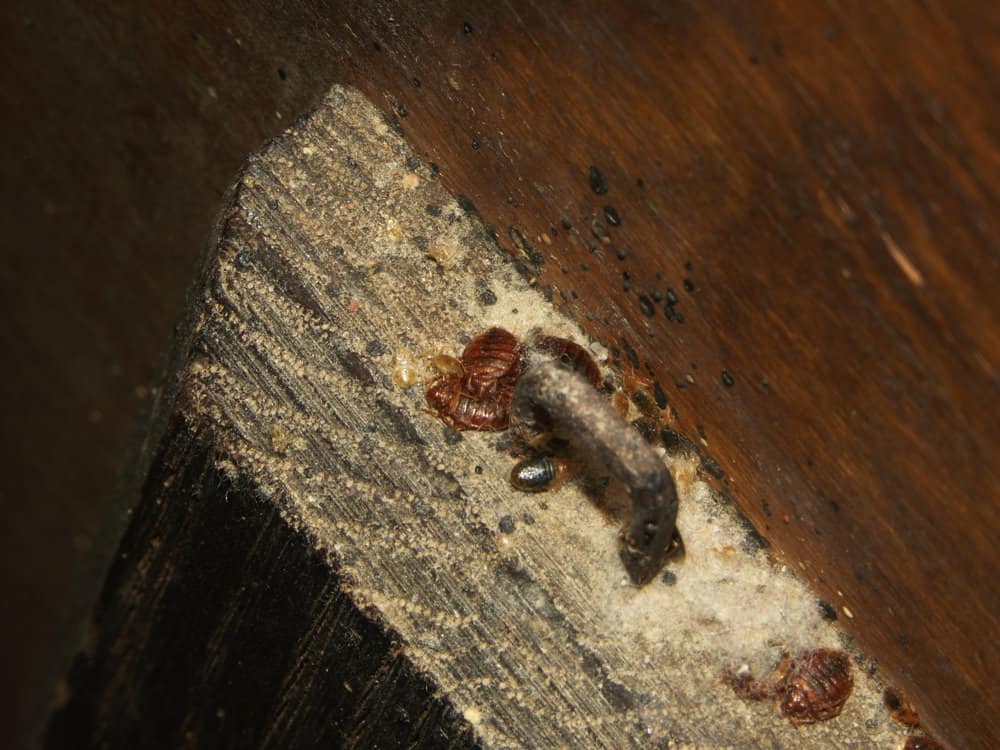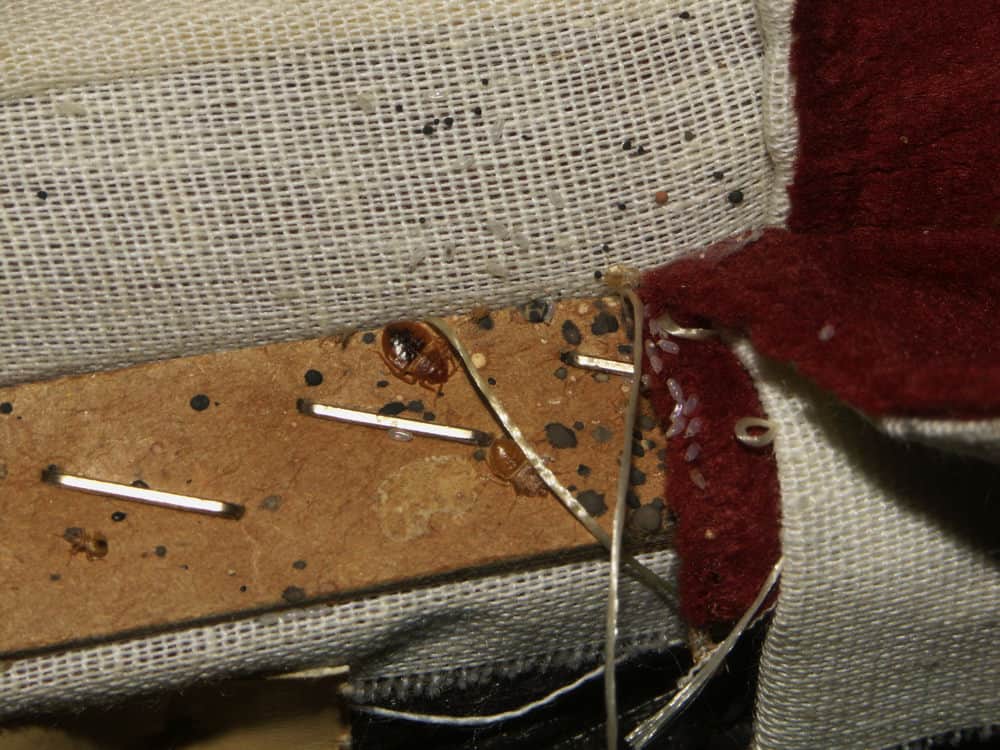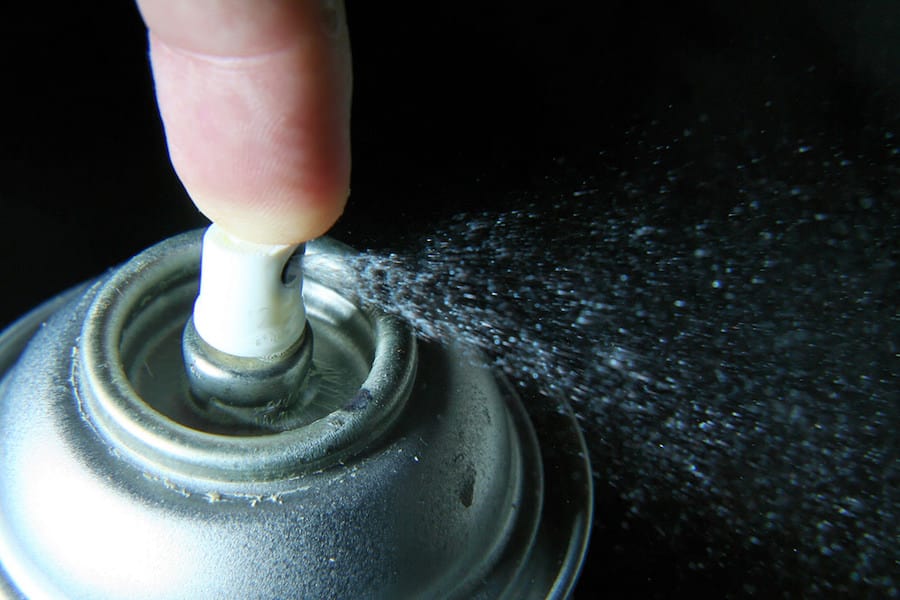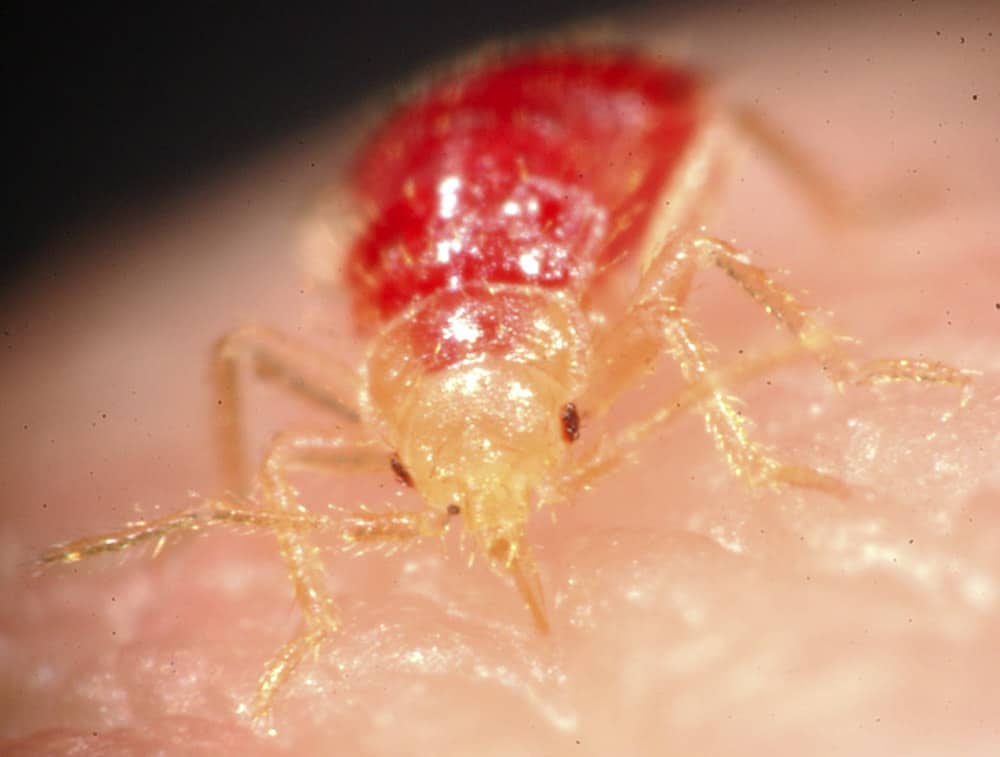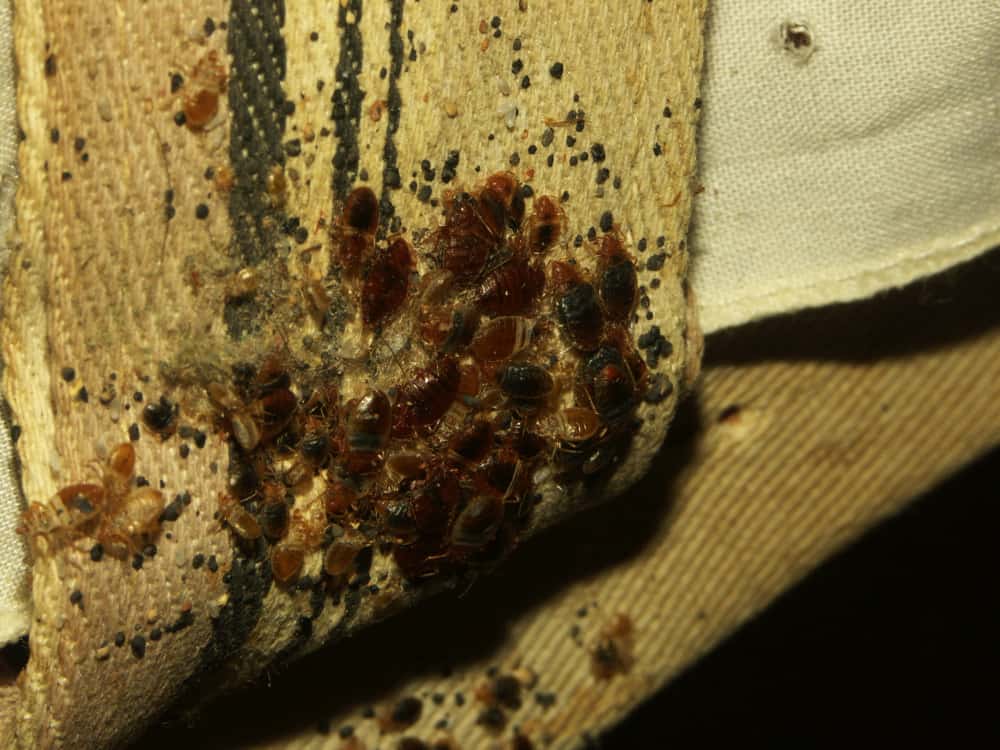How To Find & Kill Bed Bug Eggs
Bed bugs are insects, which have various life stages. We generally concern ourselves with the nymph and adult stage because those are the life stages that bite us. However, the first stage of life, the egg, is one of the hardest stages to not only locate but to kill.
In this article, I will discuss with you the bed bug egg. You will learn what the eggs look like, where they can be found, as well as how to eliminate this crucial life stage from your home and clothing.
Even if you get rid of all the nymphs and adults, you can still have an infestation when the eggs finally hatch. Read on to learn how to control the first state of bed bug infestations and regain your home and peace of mind.
What Do Bed Bug Eggs Look Like?
Bed bug eggs are very tiny in size. They measure only about one millimeter in length and are off-white in color. To get an idea, imagine about half of a grain of white rice.
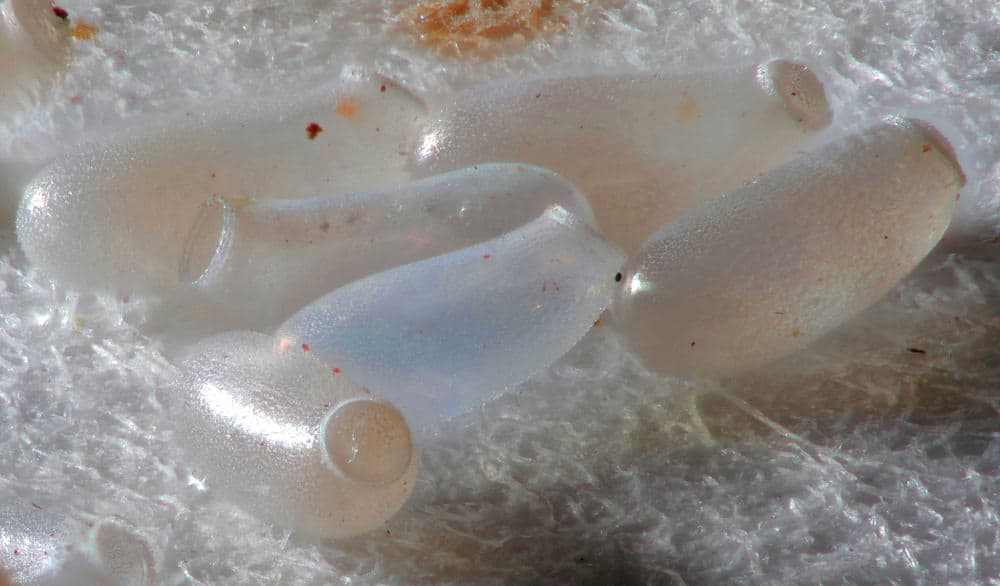
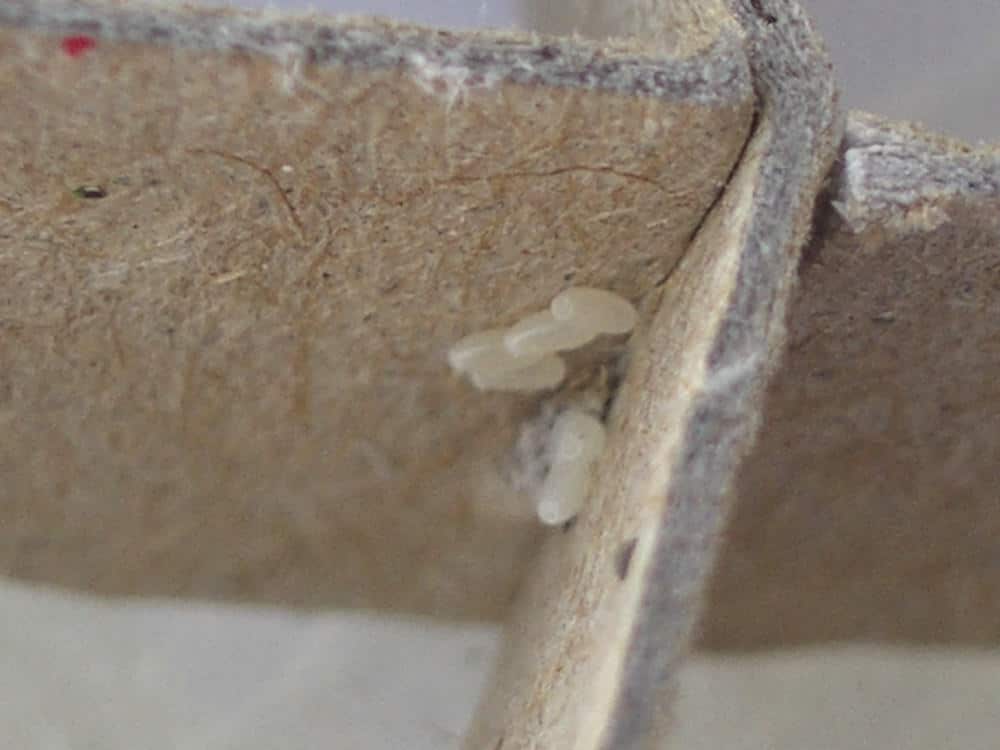
They are oval in shape. Elongated with round ends. When an egg is laid, it is attached to the surface with a strong glue-like substance that makes it especially difficult to move, remove or find.
The glue-like substance isn’t really seen with the naked eye, but you will notice a slight “wet spot” appearance around the rice-like egg if you look close enough. When I am looking for possible egg locations, I will use a magnifying glass and a flashlight to aid me in hunting these devilish eggs.
Where Do Bed Bugs Lay Eggs?
Unlike most other home pests, bed bugs are not equipped to handle slick terrains. They will stick to fabrics and wood for movement and living. You won’t find many bed bugs, or their eggs, in locations that are made of plastics or metal. However, this does not include bed frames.
As the mattress, box spring and bedding linens are so close, you will find bed bug eggs in bed frames; particularly the flat sides and in any cracks or folds.
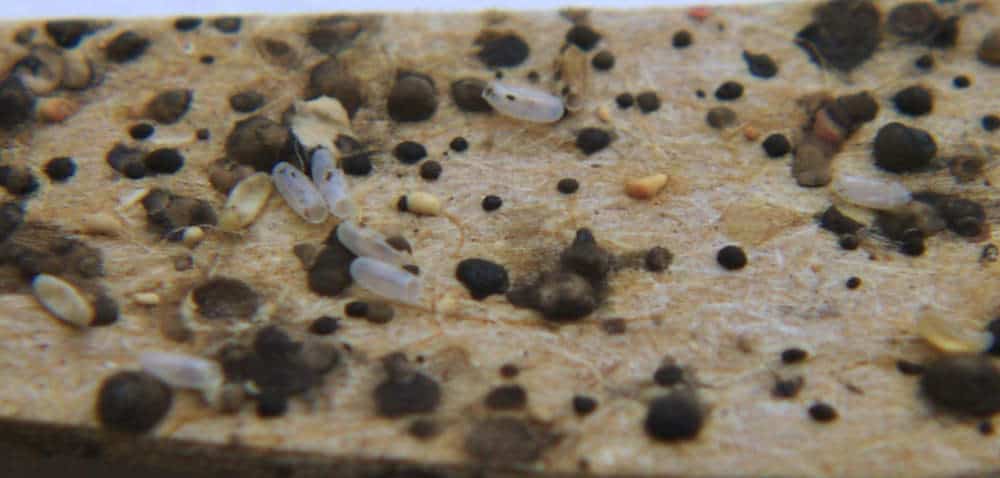
In Beds
Bed bugs get their name because of the general location they like to inhabit: namely your bed. They are small insects that prefer to move and feed at night and will stay relatively close to their main food source; you.
Due to the fact that they do not move very far from home, you will be able to find eggs in the same places in your bed that you find the nymphs and adults. When inspecting your bed, you should check anywhere that isn’t flat and in the open.

Bed buttons, along the seams, folds and edges of mattresses and box springs are common egg-laying locations. You should also check the underside of box springs and anywhere the mattress or box spring comes in contact with anything else. This includes the bed frame, floor or walls. Using mattress and box spring encasements can be a great way to keep bed bugs from occupying these areas, helping to slow the spread of infestation.
My recommended mattress protector is the SureGuard Mattress Encasement. It’s thick, strong, comes in many different sizes, and is certain to help stop bed bugs of all sizes from getting to, or from, your mattress.
To make sure you’re covered from all angles, the SureGuard Box Spring Encasement and Pillow Protectors, along with the mattress protector, will go a long way in helping to combat the infestation, and should help to ensure you sleep a bit better at night, too.
Windows and Window Dressings
Female bed bugs will tend to lay their eggs away from the masses. As a result of the rapid reproduction rate, they will feel over-crowded and try to get far enough away to avoid killing the eggs. One favorite spot is window dressings. You should inspect your curtains and drapes with special attention to any folds, hems, or contact points.
If you have curtain rods that aren’t solid, you should also inspect the fold and openings in those as well. Do not forget to check the actual windows, also. Since bed bugs are fine on wood, the window sill, window frame and around the twist locks and handles are common spots to find eggs and pregnant females.
Carpet and Flooring
Bed bugs have to get in your home somehow; usually, they tag along on a pet or the cuff or your pants. Once inside they will find their way to the primary food source, and what better way to start the trek than by using the same floor you do?
When checking carpet, you want to pay careful attention to areas you don’t use very often. These areas will include the floor where your bed frame legs are, dressers and underneath chairs.
Steamer cleaners can be a great way to kill bed bug eggs deep in the carpet fibers as the intense heat penetrates the low areas easily, killing the eggs near-instantly. Steamers also work very well on cloth furniture and mattress seams.
If you’re looking for a powerful and reliable steamer for use against infestations and at a good price, the PureClean XL Rolling Steam Cleaner is a great choice. It’s heavy-duty, made to last, and produces a great covering of extremely hot pressurized steam – exactly what you want in order to kill insects and their eggs on impact.
This steamer can be used on a wide number of surfaces and objects, including mattresses, carpets, curtains, clothing, box springs, bedding and baseboards.
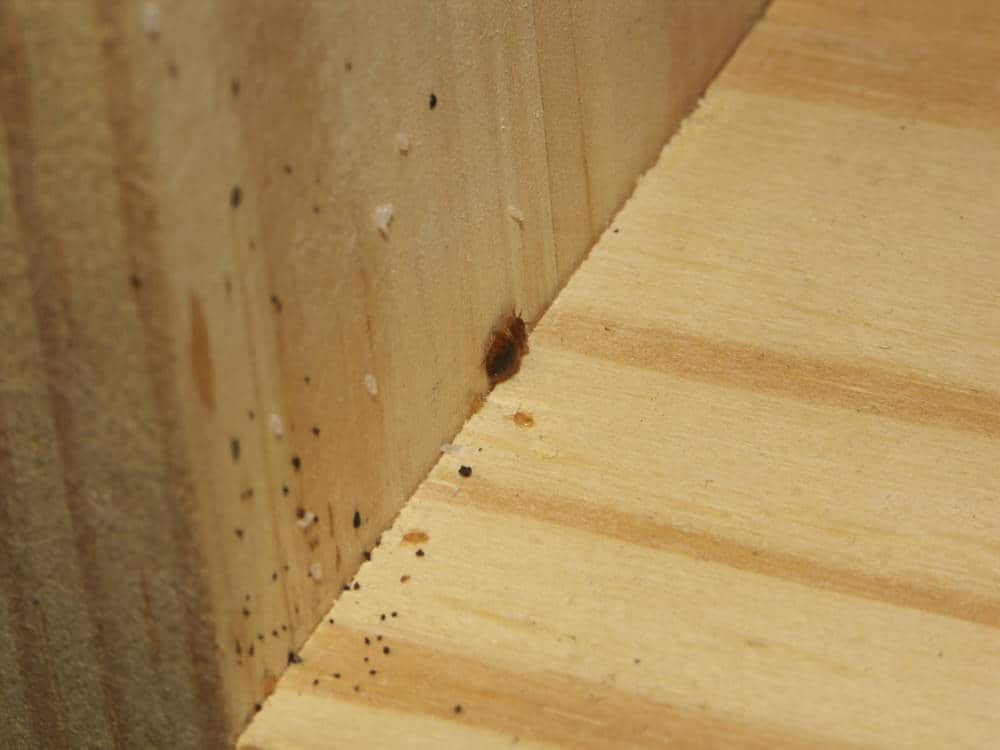
You also need to go around the perimeter of your floor near the walls and baseboards. If you have hardwood flooring, check the cracks and joints. If you have carpet, you should pull the carpet off of the tack strips at the walls and look under the edges and along the tack strips.
Other Places
Anywhere you spend a great deal of sedentary time, such as your bed, should be checked. This will include your computer desk, your favorite recliner, and the bathroom. Depending on your infestation level, you should regularly check closets, clothing and inside dresser drawers or bookshelves that are close to these areas.
Although bed bugs don’t have wings and cannot fly, they are very efficient climbers, so don’t neglect hiding places high up and around the ceiling when you’re searching for them.
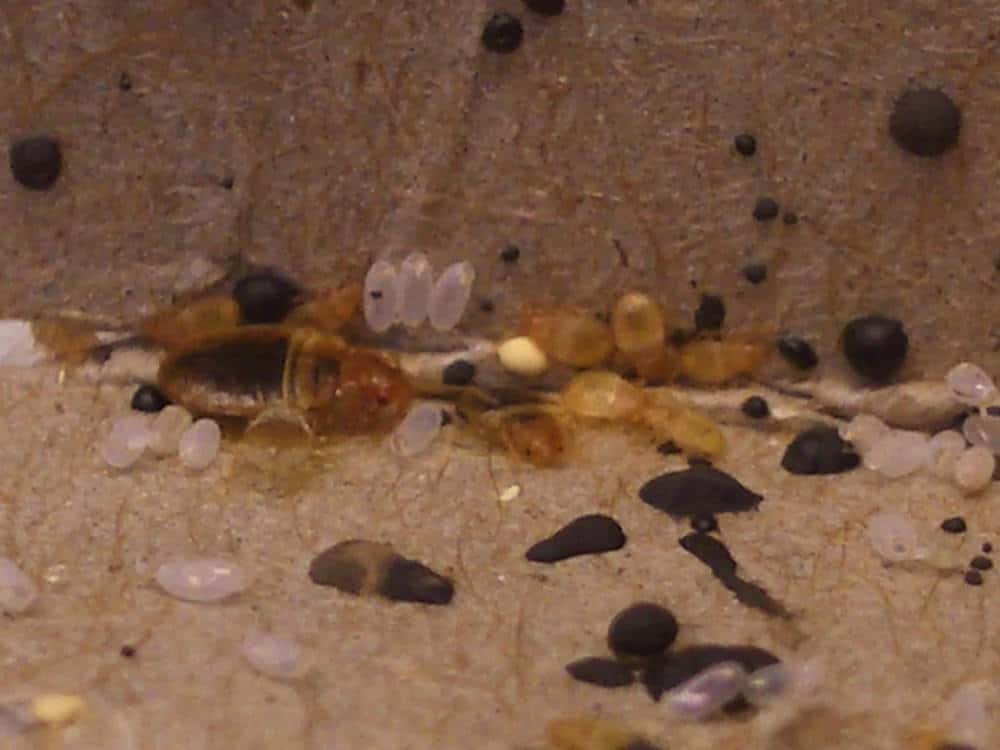
Do Bed Bugs Lay Eggs On Your Body or in Your Hair?
Unlike critters like fleas and lice, bed bugs do not have the required limbs to attach to our bodies nor survive in our hair. They use us as a food source and don’t generally stay there all the time.
The little insects will come to us in the night get their meal and return to their “home.” They lack the claws and attachment limbs to cling to our hair for very long, and the egg won’t stay attached to our bodies.
While you should always check your clothing, you have little to worry about in regard to your hair or skin.
Due to their size, color and shape, adult bed bugs are often confused with ticks. If you do notice bugs in your hair or on your body, it will most likely not be a bed bug. Ticks, fleas, and lice will use our bodies and hair as a food source and a home, where bed bugs only use us for food.
Anything staying on your body or in your hair is likely one of the other culprits and not a bed bug.
How Long Until Bed Bug Eggs Hatch?
Once the egg is laid by the female, she will generally leave it on its own. When they do hatch, they are ready to feed on their first blood source almost immediately. Each nymph stage will need one blood-feeding to molt into the next, and there will be five molts before they reach adulthood.
The egg will hatch in as little as six days, but it could take up to two and a half weeks. Most of the hatching time is determined by the temperature of the room. The closer to 80 degrees, the sooner they will hatch.
As you can see, with eggs being laid every day and only a month to a month and a half to adulthood, these bugs can create a very large colony, very fast. Controlling the eggs is crucial for eliminating the bed bugs from your home.
How Many Eggs Do Bed Bugs Lay?
Female bed bugs will lay one egg at a time. Unlike other insects like ants, they do not deposit large amounts of eggs at a given time. They don’t have nests and will not generally lay eggs in only one particular spot. You can find small clusters of no more than about 50 eggs, but you will usually find less than a dozen in one place.
However, most female bed bugs will lay up to 5-12 eggs in an entire day, and will leave eggs behind every day of their adult life. This can result in an average of 500 eggs per each female’s adult life.
The temperature will have the largest impact on their egg-laying. The optimal temperature for laying eggs is at 80 degrees Fahrenheit (26.7 degrees Celsius). The colder the temperature, the fewer eggs per day and the warmer the temperature, the fewer eggs per life cycle, as bed bugs do not survive well in very high heat.
When you calculate that an average female will lay 500 eggs in 4 months, and there can be more females per male in an infestation, you will soon realize how many eggs can accumulate in a very short amount of time.
Infestations can go from mild to moderate to severe in just a few weeks’ time.
Which Temperature Will Kill Bed Bug Eggs?
Heat is one of the easiest and most efficient methods to kill bed bugs. Any stage of the bed bug life cycle, including eggs, will die at a sustained temperature of over 120 degrees Fahrenheit (60 degrees C.).
For clothing and bedding, you can throw them in the dryer on high heat for about 30 minutes to an hour to kill any bugs. For larger items, such as beds, dressers and the like you will need specialized heat equipment. Heat treatment should normally be left to the professionals, although there are a few good personal bed bug heat treatment products currently on the market.
My favorite way to heat household items to a temperature that is sure to kill all bed bugs and eggs without needing to purchase expensive pest control heat treatment is to use a ZappBug Heater, which is specially designed to kill all stages in the bed bug life cycle.
Simply place infested items into the ZappBug heater and it will automatically reach the all-important bed bug killing temperature, so you can be sure the items come out all-clear.
Large and small versions are also available.
Bed bugs can survive in almost any environment and at very extreme temperatures. We haven’t found a cold temperature that will kill them extremely quickly, but heat works well.
If you have a large infestation, you will need to hire a professional to help eliminate the problem. Killing the eggs and adults should be the priority to get them under control. High heat applications can be administered by professionals.

How To Kill Bed Bug Eggs
Aside from throwing your clothes and sheets in the dryer for an hour, there are other methods of killing bed bug eggs that are also effective. Most methods are a Do It Yourself manner.
Anytime you are fighting pests in the home, especially bed bugs, you will need to make preparations and have due diligence. Unlike the touting of some product labels, eliminating bed bugs is not a one-time affair. You will need to work to remove them all continuously. Leaving a single bed bug can result in the reformation of the infestation.
Depending on which method you choose, the most effective killer of bed bugs eggs will always be heat (always, until science can create a chemical to penetrate the eggshell and kill them instantly).
The eggs are coated with an adhesive that not only helps them attach to the surface, but makes them harder to get to and kill effectively. Scrubbing the area with a brush will loosen the eggs from their hold and make them easier to remove and kill.
Vacuum
Using a good vacuum with a HEPA rated filter is one method to remove the bed bug eggs from your home. While this method will not generally kill the eggs, you can remove them and wrap them so they cannot escape and infest your home further.
When it comes to choosing a vacuum in your fight against an infestation, you need a product that can be reliable, and one that is powerful enough to create secure suction deep within fabric and carpet fibers. And remember; it’s imperative you choose a vacuum that’s installed with a HEPA filter to ensure it’s impossible for insects to escape once captured.
My personal favorite for this sort of job is the medium-priced Shark Navigator Upright Vacuum, which easily ticks all of the boxes I’ve just mentioned, as well as being lightweight and easily maneuverable.
If you decide to vacuum, you must first find the areas where the eggs are located, which I discussed earlier in this article. Running a cleaning brush over the area will loosen the eggs and allow the vacuum to pick them up.
You must have a HEPA rated filter to catch the eggs. The HEPA filters will capture particles down to 0.3 microns and will also help eliminate dust, and shells and feces of the bugs.
Once you scrub and vacuum the area, you must clean your vacuum well. Remove the bag and filter after every use and place everything in a sealed plastic bag for disposal. When you dispose of the plastic bag, do so outside of the home and not just in your kitchen trash to wait until next Monday for it to be sent out for collection.
You can also find ultraviolet heat vacuums that will suction up the eggs and apply high heat to kill them. These vacuums can become expensive, but it may be worth the extra cost to know the eggs are dead.
Pesticides and Insecticides
Bed bugs are notorious for being resistant to most professional sprays and pesticides. However, even those that aren’t immune, still won’t easily be killed when they are just eggs. To kill an egg, it must have the shell penetrated to kill the embryo inside.
You should always check the labels to ensure that eggs are listed. If it doesn’t say it kills the eggs outright, the product should be avoided.
One of the best bed bug sprays that I’ve yet to personally use is the completely natural Bed Bug Patrol Bed Bug Killer. Not only does it have a 100% kill rate against live bed bugs in controlled tests, but it’s also child and pet friendly. This product can be used against both light and heavy infestations, and most importantly, it’s laboratory tested and completely chemical-free.
There are also home remedies with chemicals that have shown promising results. A 91 percent isopropyl alcohol sprayed on the eggs can kill most, if not all of them in a few days. If you use the solution, put it in a spray bottle and spray after scrubbing the egg area. Scrubbing beforehand will help eradicate some of the adhesives, and therefore help the alcohol penetrate the eggshell.
Isopropyl alcohol has also been found to prevent females from laying new eggs. This is a good measure to begin the elimination process of the entire infestation by killing the eggs you can find and preventing new ones from being laid.
Dangers of using alcohol should be noted though. Alcohol is highly flammable. It may also degrade or stain fabrics. You should always test small areas before widespread use and keep away from high heat sources and open flames.
How To Get Bed Bug Eggs Out Of Clothes
When bed bugs lay eggs on your clothes, they can be especially difficult to remove. You can throw your clothes through the washer and dryer to kill the eggs, but they still may remain.
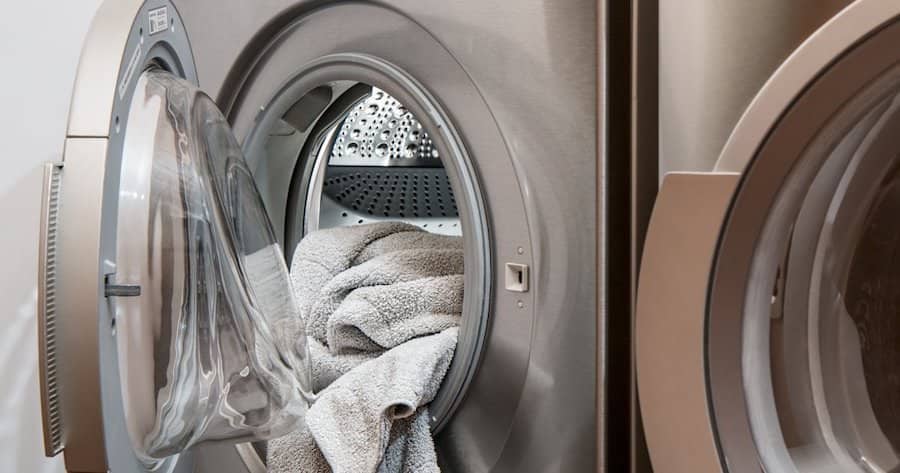
Even if the egg is dead, the adhesive properties can make it stay on your clothing. To remove them you only have a few options.
- Handpick each egg off your clothing.
- Wash and dry on high heat a few times until the adhesive disintegrates.
- Scrub your clothing with a brush or on a washboard.
- Scrub and vacuum your clothing with a HEPA rated filtered vacuum.
Summary
Bed bugs begin their life cycle as an egg. These eggs are very difficult to find, see and kill. Taking preventative measures is always a recommended course of action.
However, once you have an infestation, controlling the egg population is key to winning the war against bed bugs. High heat is the only sure-fire method of killing eggs. This can be very difficult to accomplish though, because of the spaces eggs are laid in.
Wash and dry all clothing, linens and window dressings with high heat. If your clothing is dry clean only, you can purchase special bags to put them in to dry them in your home dryer.
Locate all of the possible egg-laying spots around your home and treat them as soon as possible. Scrubbing the egg area with a scrub brush will remove the adhesive and allow for shell penetration by chemicals or suction by a vacuum.
You must, above all, stay diligent in your search and removal efforts and don’t be ashamed or afraid to call in professional help if the infestation becomes overwhelming. The sooner you begin the cleaning out phase of your bed bug infestation, the easier it will be to control.
With a possible 500 eggs per female in just a few short months, eliminating the bed bug eggs should be priority number one.


